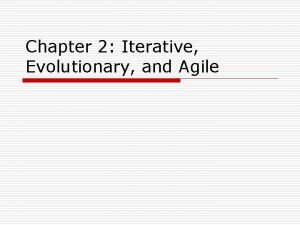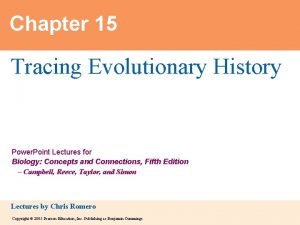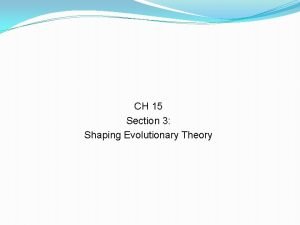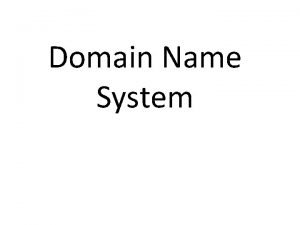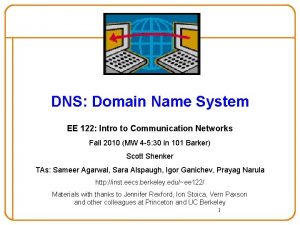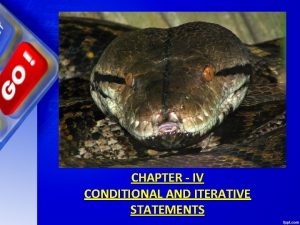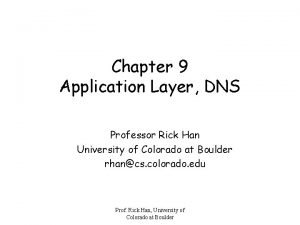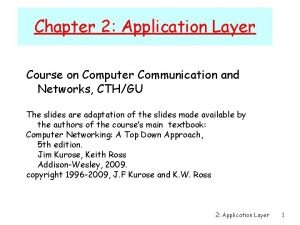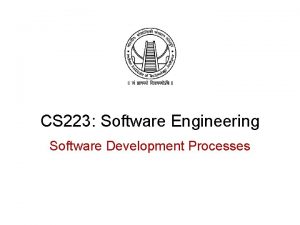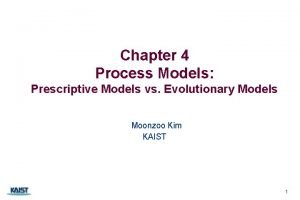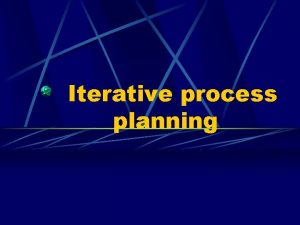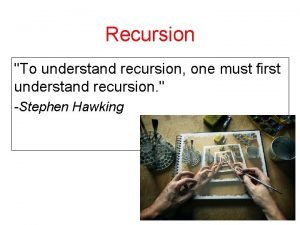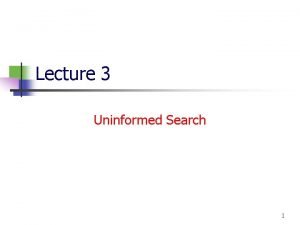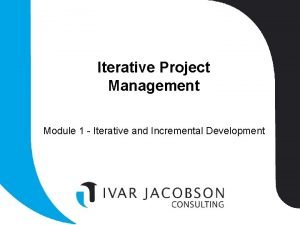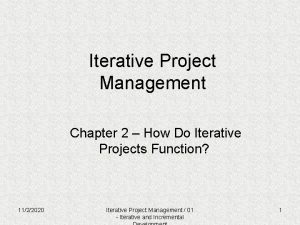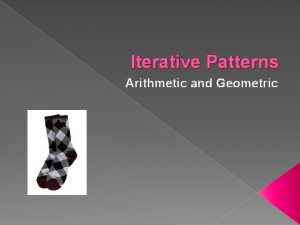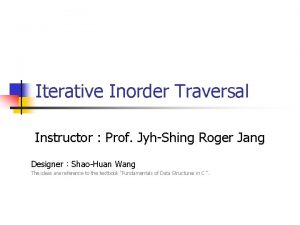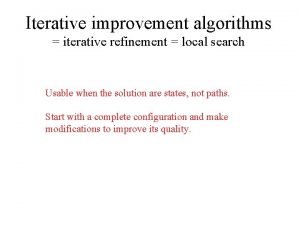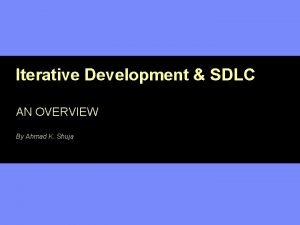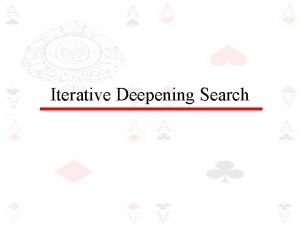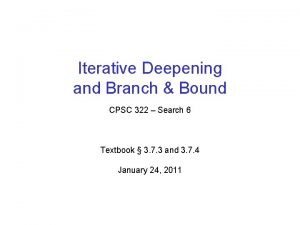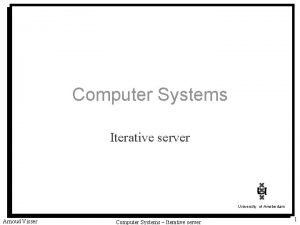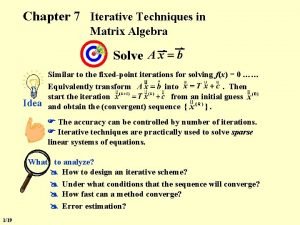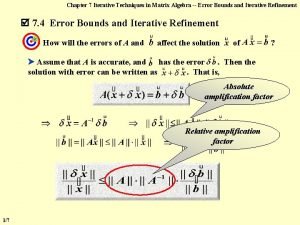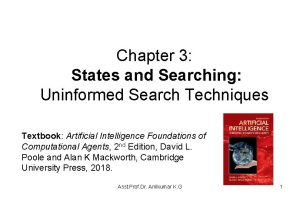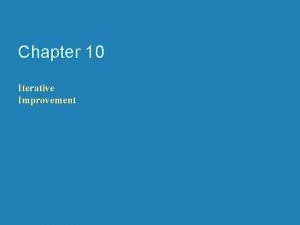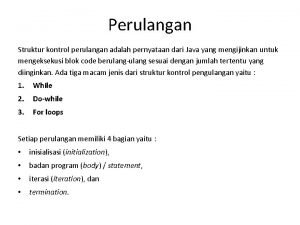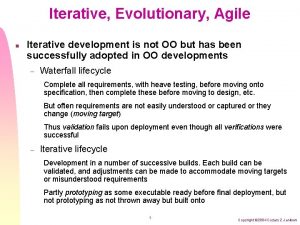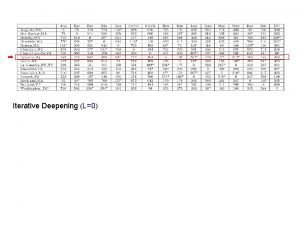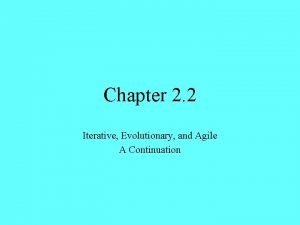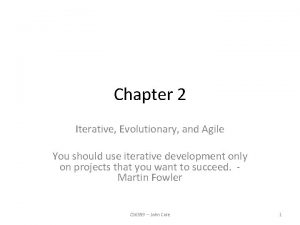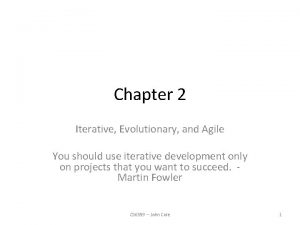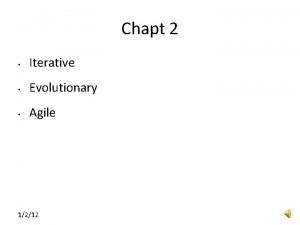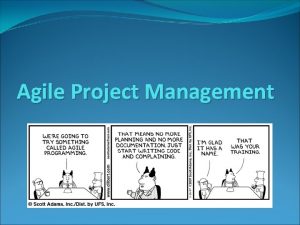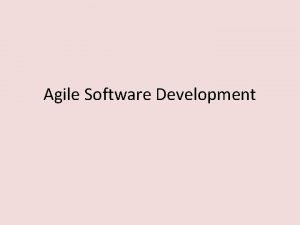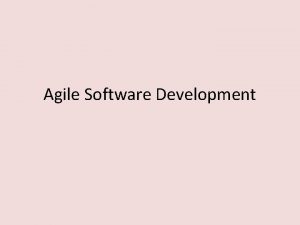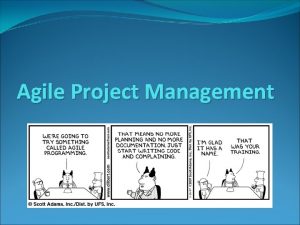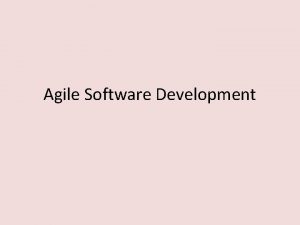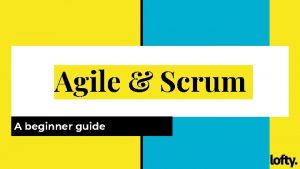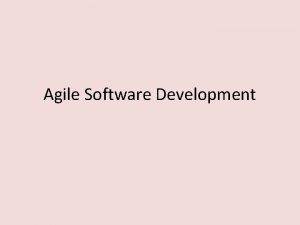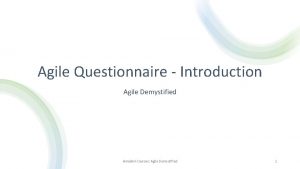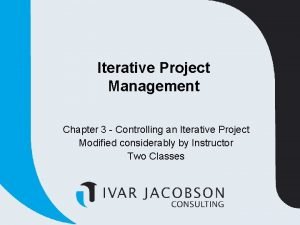Chapter 2 2 Iterative Evolutionary and Agile A




























- Slides: 28

Chapter 2. 2 Iterative, Evolutionary, and Agile A Continuation

2. 4 Example Iterative and Evolutionary Analysis and Design? • Excellent example. Many details will be forthcoming to explain all this. • Overview of a simple example on 20 iterations (over a year) project: 1. Before the first iteration, hold an initial requirements workshop with client and senior developers. In the UP this is the Inception Phase (covered in detail in next lectures) o Define the project objectives; o Do high-level requirements analysis by identifying use cases (say 30 are found) and features; (use cases covered in a later chapter) 30 is a large number!!!! (High level: naming; short description; not much more in high level (façade) use cases). Place holders…. o Study problem domain…. o Identify non-functional requirements (look and feel, efficiency etc. ) o These are typically ‘quality factors’ such as reliability, efficiency, scalability, learnability, maintainability, security, correctness, etc. 2 To be covered later)

2. 4 Example Iterative and Evolutionary Analysis and Design? o Before the first iteration – continuing…… o Pick the 10% of the use cases with a blending of: o Architecturally Significant; (require significant work!! Design, build, test…) o High marketing value; high business value; core needs o High risk Address these first!! this leads to say parts of three use cases: say UC 2, UC 11 and UC 14; Recognize that these are likely scenarios WITHIN each of these use cases and not the entire use case…. o Do a detailed analysis of the functional and non-functional requirements for these three use cases (or scenarios from the use cases); Note perhaps 10% of use cases are now significantly analyzed. 90% not. o Review everything with everybody; o This is done before we actually START iteration one. This is the iteration planning for iteration 1, which will take place in the Elaboration Phase. o This (and much more – vision docs, risks lists, business rules, etc. ) is done during Inception. Sometimes, we say that there is one iteration in Inception. Arguable.

2. Then the developers alone hold an iteration planning meeting to define a subset of UC 2, UC 11 and UC 14 for the first iteration to fit within a, say, 4 weeks time box (do not be too greedy!). Document the subset. Maybe tentatively schedule 2 nd and more tentatively the 3 rd iterations; Excellent. Realize these are scenarios. Scope the iteration. 3. Iteration 1 (in UP terms this is the start of the Elaboration Phase) which mainly deals with critical architectural modelling and risk reduction… o Perform OOA using the Domain Model captured in UML; review by all developers (3 days? ); What is domain modelling? ? Also includes several additional diagrams such as sequence and collaboration diagrams; perhaps state diagrams and more. But at a high analysis level… o Perform OOD documentation the Design Model using UML; (in pairs, review by all) (eg. 2 days); Design in UML; decide on methods, etc… Perhaps some sequence / communication diagrams. 4

Continuing…. o Start programming, integrating and testing using previous UML models as starting points; Try to update models; ( o (Using Scrum as the agile methodology here) hold daily stand-up meetings (e. g. two weeks); o One week before the end review and de-scope if necessary; Yes. (Since work efforts should be prioritized, those scenarios (work units) not able to be done within the time-box are considered for later iterations. ) o On Tuesday of the last week: code freeze to provide increment; o On Wednesday demo partial system to external stakeholders: get and document feedback; measure according to predefined expectations; assessment!!! o 2 nd requirements workshop: refine previous workshop document and detail another important 10 -15% of the use cases o End of iteration 1

4. 5. 6. Repeat for Iteration 2 : similar steps; Four iterations and five requirements workshops so that at the end of iteration 4, perhaps 80% or 90% of the requirements have been written in details but only 10% of the system has been implemented; The end of the Elaboration Phase when most of the requirements have been detailed by iterations and some the system is available. All estimates should be reviewed Note this is the end of the Elaboration Phase (UP discussed ahead) All of the use cases / scenarios that have high risk, are architecturally significant, and provide core functionalities are addressed. Requirements are significantly refined due to feedback and assessment. Rhythm is established; initial increments provided to stakeholders. And yes, we are about 20% into the duration of the overall project. Can redo project estimates that will be much more trustworthy!! Life Cycle Architectural milestone – go / no-go decisions can be made. (more ahead in RUP) The UP Construction Phase can start: many more iterations, major requirements change is less likely during this period. Can be more ambitious on the amount of work to be performed. Keep learning and getting feedback; In the UP the last phase is the Transition Phase: beta tests and deployment 6

A look at elaboration iterations 7

• At the end of Elaboration, the second phase of the Unified Process, there is a huge milestone. The milestone is called the Life Cycle Architecture milestone. • Perhaps the most critical phase of the Unified Process • A go-no go decision is made to proceed or stop • All the really tough stuff is addressed. Major risks mitigated; architecturally significant use – cases resolved … • Much more when we formally cover the Unified Process. 8

Inception Elaboration Construction Transition Iteration 1 Iteration … Use Case A Simplified … … Use Case A Full … Use Case … Use Case B Full … … Use Case … OOA OOD Coding & Testing Integration Fig 2. 8 a Agile UP Schedule Overview 9

You Know you did not Understand Iterative Development When: • You try to define all the requirements details before you start (or the entire detailed design; • You spend weeks doing UML modelling before programming; • You think that inception = requirements analysis, elaboration = design and construction = coding; • Your iterations are months long rather than weeks; • Your plans are fussy, overly detailed, document led and rigorously enforced; • People work in isolation, handing one document after another to the next person (e. g. requirements specification from analyst to a designer, design document to programmer, code to tester); 10

Very Important – again: • Which use cases to schedule in the elaboration phase? (at the beginning of a project). • Select use cases for elaboration and action according to: – Risks : to drive down the highest risks early on; – Core value Client needs : to build visible core features that the client cares most about – Architecturally-significant use –case scenarios. 11

6 What are Agile Methods and Attitudes? • “Agile methods apply time-boxed iterative and evolutionary development, that employ adaptive planning, promote incremental delivery, and include other value and practices that encourage agility – rapid and flexible response to change. “ • No single way to pin down agile • Many agile approaches. • All have: – Time-boxed iterations and – Evolutionary refinement of plans, requirements and design – Based on feedback and measurement. • Advocates also push that agile development includes simplicity, lightness, communication, and self-organization of teams….

Agile Methods • Perhaps the most popular is Scrum (drawing coming up) • Characteristics: – Common project workroom – Self-organizing teams – Daily stand-up meetings • See references and assigned homework • Another popular (much less popular) agile approach is Extreme Programming XP (drawing coming up) • Characteristics – Programming pairs – Test driven development • See references and assigned homework.

Agile Methods - continued • Another is the Unified Process (Rational Unified Process – the RUP) • Characteristics – Can include some of the practices from Scrum, XP, and several others. • Other agile methods include Feature-Driven Development (FDD), and DSDD. • Use UML modeling for the difficult to understand features – architecturally significant features. For understanding the features!! – Class modeling (static); sequence and communication diagrams (dynamic)… and more. 14

The Agile Manifesto • Individuals and interactions over processes and tools • Working software over comprehensive documentation • Customer collaboration over contract negotiation • Responding to change over following a plan. . • See the Agile Principles on page 29. • See www. agilemanifesto. com

Principles behind the Agile Manifesto • We follow these principles: • Our highest priority is to satisfy the customer through early and continuous delivery of valuable software. • • Welcome changing requirements, even late in development. Agile processes harness change for the customer's competitive advantage. • Deliver working software frequently, from a couple of weeks to a couple of months, with a preference to the shorter timescale. • Business people and developers must work together daily throughout the project. • • Build projects around motivated individuals. Give them the environment and support they need, and trust them to get the job done. • The most efficient and effective method of conveying information to and within a development team is face-to-face conversation. 16

Principles behind the Agile Manifesto • Working software is the primary measure of progress. • • Agile processes promote sustainable development. The sponsors, developers, and users should be able to maintain a constant pace indefinitely. • Continuous attention to technical excellence and good design enhances agility. • Simplicity--the art of maximizing the amount of work not done--is essential. • The best architectures, requirements, and designs emerge from self-organizing teams. • At regular intervals, the team reflects on how to become more effective, then tunes and adjusts its behavior accordingly. 17

XP Overview – one pager

Scrum One-Pager Roles PO Product Owner: Set priorities SM Scrum. Master: Manage process, remove blocks Key Artifacts Product Backlog ·List of requirements & issues ·Owned by Product Owner ·Anybody can add to it ·Only Product Owner prioritizes Sprint Goal ·One-sentence summary ·Declared by Product Owner ·Accepted by team Sprint Backlog ·List of tasks ·Owned by team ·Only team modifies it T Team: Develop product SH Stakeholders: observe & advise Blocks List ·List of blocks & unmade decisions ·Owned by Scrum. Master ·Updated daily Increment ·Version of the product ·Shippable functionality (tested, documented, etc. ) Key Meetings Sprint Planning Meeting ·Hosted by Scrum. Master; ½-1 day ·In: Product Backlog, existing product, business & technology conditions 1. Select highest priority items in Product Backlog; declare Sprint Goal 2. Team turns selected items Daily Scrum into Sprint Backlog ·Hosted by ·Out: : Sprint Goal, Sprint Scrum. Master Backlog·Attended by all, but Stakeholders don’t speak ·Same time every day ·Answer: 1) What did you do yesterday? 2) What will you do today? 3) What’s in your way? Sprint Review Meeting ·Team updates Sprint ·Hosted by Backlog; Scrum. Master updates Blocks List ·Attended by all ·Informal, 4 -hour, informational ·Team demos Increment ·All discuss ·Hold retrospective ·Announce next Sprint Planning Meeting Development Process Product Backlo g Incremen t Sprint Planning Meeting Sprint: 30 days each Sprint Goal Daily Scrum Daily Work Sprint Backlo g Blocks List Product Incremen t’ Sprint Review Meeting Product Backlo g’

• Scrum Master is responsible for making sure a Scrum team lives by the values and practices of Scrum. The Scrum. Master protects the team by making sure they do not over-commit themselves to what they can achieve during a sprint. • The Scrum. Master facilitates the daily scrum and becomes responsible for removing any obstacles that are brought up by the team during those meetings. • The Scrum. Master role is typically filled by a project manager or a technical team leader but can be anyone. • Scrum Sprint: Simple statement of the Goal of a Scrum. Sprint Should be stated terms of value recognizable to the Product Owner (usually: working software). The goal helps team members focus: to recognize what is important when weighing options during the Scrum Sprint.

• Daily Scrum: On each day of a sprint, the team holds daily meetings (“the daily scrum”). Meetings are typically held in the same location and at the same time each day. Ideally the daily scrums are held in the morning as they help set the context for the coming day's work.

2. 7 Agile Modeling • Remember, Visual Modeling is one of the Best Practices… • When we do UML Modeling, we are really doing OOA/OOD. • Agile Modeling is used to understand the problem space and the solution space. • Not to directly support programming!!

Agile Methods - Principles • Model in pairs!! Don’t model on your own. • Share understanding. • Do static views – – UML class diagrams and then • Do dynamic views – – Interaction diagrams (sequence and collaboration diagrams)

Agile UP Note: • UP never meant to be a heavy-weight methodology, even though some of the activities tend to be implemented with too much strictness. • Meant to be agile. • Will cover the RUP and Process in next series of slides. • One last look at two important models: – A static class diagram and a – Dynamic interaction (sequence) diagram.

Compare Domain Model Entity with Design class Diagram Static Views

Fully Developed Class Design Model 1 Uses Store 1 address : Address name : Text Product. Catalog add. Sale() 1 Product. Specification 1 Looks-in 1 get. Specification() description : Text price : Money item. ID: item. ID Contains 1 1 Houses 1 1 * Register Sale Captures end. Sale() enter. Item() make. Payment() Describes Illustrates non-attribute visibility 1 Logs-completed 1 Date : Date is. Complete : Boolean time : Time become. Complete() make. Line. Item() make. Payment() get. Total() * Sale. Line. Item Contains quantity : Integer 1 get. Subtotal() Payment amount : Money 1 Paid-by 1

Sample (abbreviated) Interaction Diagram

More on Agile UP • UP is both iterative and evolutionary. • Requirements and Designs are not completed before implementation. • Requirements and Design are refined through the iterations based on feedback. • No detailed plans here; No fine-grained plans here. • Iteration plans are only planned one iteration in advance due to the need for feedback on the previous iteration. • Overall plans are called Phase Plans or Evolution Plans. Detailed plans are the iteration plans.
 Iterative and evolutionary development
Iterative and evolutionary development 5 fingers of evolution
5 fingers of evolution Chapter 15 tracing evolutionary history
Chapter 15 tracing evolutionary history Chapter 15 section 3 shaping evolutionary theory
Chapter 15 section 3 shaping evolutionary theory Recursive vs iterative dns
Recursive vs iterative dns Recursive and iterative query
Recursive and iterative query Sequencing selection and iteration
Sequencing selection and iteration Recursive and iterative query
Recursive and iterative query Application layer
Application layer Pros and cons of iterative model
Pros and cons of iterative model Strengths and weaknesses of evolutionary theory page 386
Strengths and weaknesses of evolutionary theory page 386 It advocates orderly approach to software engineering
It advocates orderly approach to software engineering Iterative process planning
Iterative process planning Iteration vs recursion
Iteration vs recursion Iterative deepening a* search
Iterative deepening a* search Iterative project planning
Iterative project planning Iterative project management
Iterative project management Iterative patterns
Iterative patterns Iterative inorder
Iterative inorder Iterative improvement algorithm
Iterative improvement algorithm Iterations
Iterations Iterative deepening search
Iterative deepening search Iterative deepening search example
Iterative deepening search example Iterative server
Iterative server Iterative techniques in matrix algebra
Iterative techniques in matrix algebra Iterative techniques in matrix algebra
Iterative techniques in matrix algebra Iterative deepening search procedure is
Iterative deepening search procedure is Iterative improvement algorithm example
Iterative improvement algorithm example Perulangan java
Perulangan java
